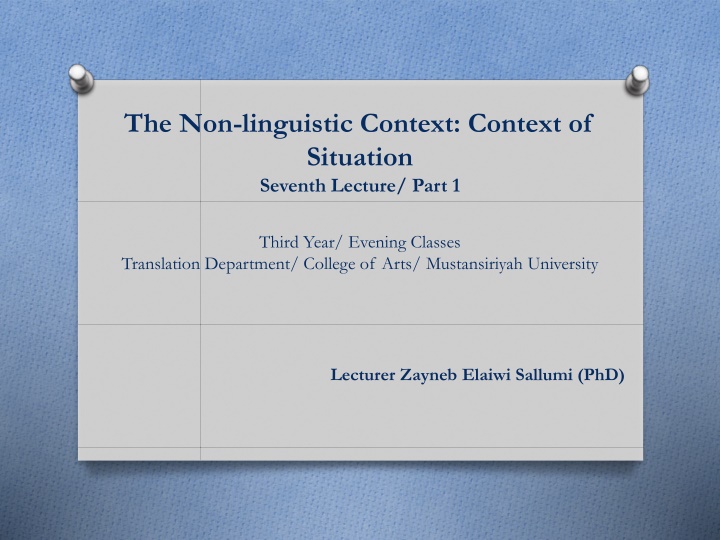
Understanding the Context of Situation in Language Study
Explore the concepts of context of situation in language study from the perspectives of scholars like Malinowski and Firth. Discover how language is intertwined with everyday activities and social functions, challenging traditional views on language as a mere vehicle for conveying meaning. Dive into the complexities of translation, primitive language, and the nuances of linguistic analysis within different cultural contexts.
Download Presentation

Please find below an Image/Link to download the presentation.
The content on the website is provided AS IS for your information and personal use only. It may not be sold, licensed, or shared on other websites without obtaining consent from the author. If you encounter any issues during the download, it is possible that the publisher has removed the file from their server.
You are allowed to download the files provided on this website for personal or commercial use, subject to the condition that they are used lawfully. All files are the property of their respective owners.
The content on the website is provided AS IS for your information and personal use only. It may not be sold, licensed, or shared on other websites without obtaining consent from the author.
E N D
Presentation Transcript
The Non-linguistic Context: Context of Situation Seventh Lecture/ Part 1 Third Year/ Evening Classes Translation Department/ College of Arts/ Mustansiriyah University Lecturer Zayneb Elaiwi Sallumi (PhD)
The term Context of Situation is associated with two scholars B. Malinowski: an anthropologist J. R. Firth: a linguist Both were concerned with stating meaning in terms of the context in which language is used, but in rather different ways.
Malinowskis Viewpoint O Malinowski s interest in language derived from his work in the Trobriand Islands in the South Pacific. He was particularly concerned with his failure to produce any satisfactory translations for the texts he had recorded. His arguments were based on observing the way in which the language of the people he was studying fitted into their everyday activities, i.e. studying language as it is used within its context of situation by people in their daily- life activities.
O Phaticcommunion is where the words dont convey meaning but have a purely social function. O The child uses words as activeforces with which to manipulate the world around him right from the babbling stage. In a similar vein, the primitive man uses words to gain power. O Language as a mode of action and not a mirror of reflected thought as the language used in books. O His remarks about the language as a mode of action are useful in reminding us that language is not simply a matter of stating information.
Two reasons why we cannot wholly accept his arguments: O Firstly: He believed that the mode of action aspect of language was clearly seen in the basic needs of man, as in the languages of the child or of primitive man. He assumed that the language he was considering was more primitive than our own and more closely associated with the practical needs of the primitive society. He assumed that the difficulties of translation were due to the differences in the nature of languages and that the need to invoke context of situation was more important when dealing with primitive languages.
Malinowski was mistaken, why? Although there might be primitive people, who lack the knowledge and skill of the civilized ones, there is no sense in which a language can be regarded as primitive. Many languages may not have the vocabulary of the modern society, but this is a reflection of the interests of the society. The difficulties of translation he noted result only from the differences between the languages, not the fact that one is more primitive.
O Secondly: His views don t provide the basis of any workable semantic theory. He doesn t even discuss the ways in which context can be handled in a systematic way, to provide a statement of meaning. If context is to be taken as an indication of meaning, all stories would have the same meaning. His solution was to invoke secondarycontext , the context within the narrative; but that has no immediately observable statues.



















